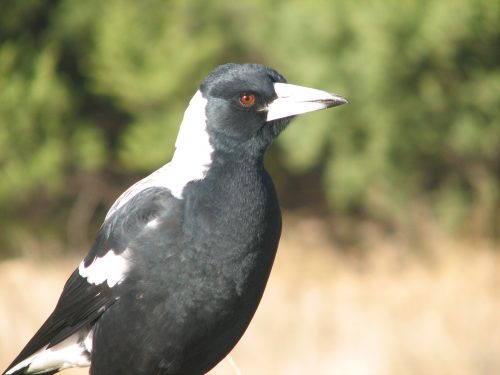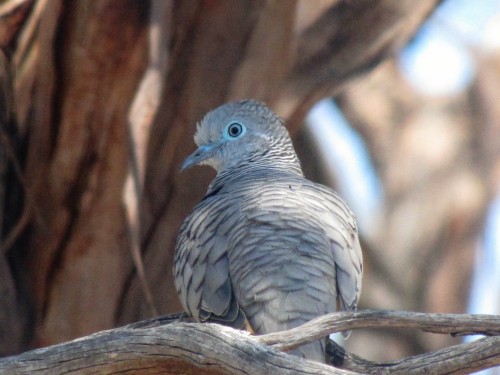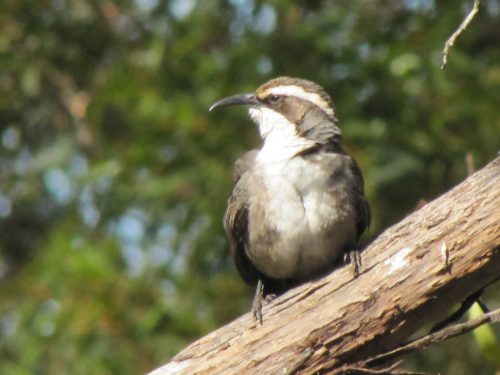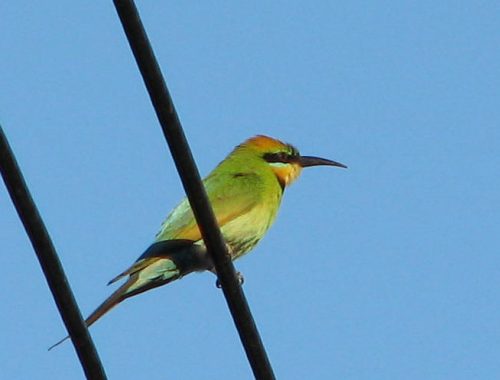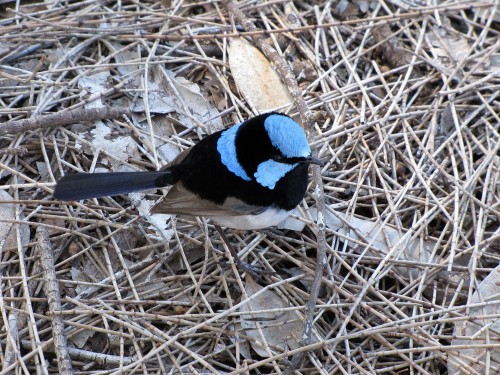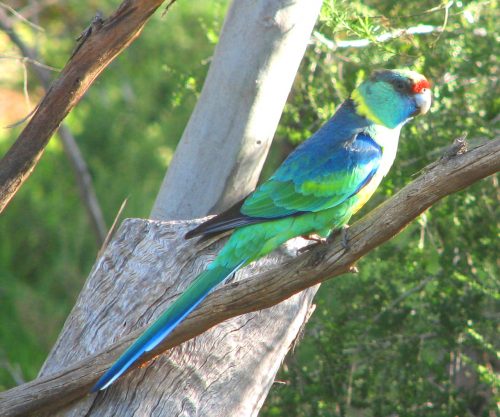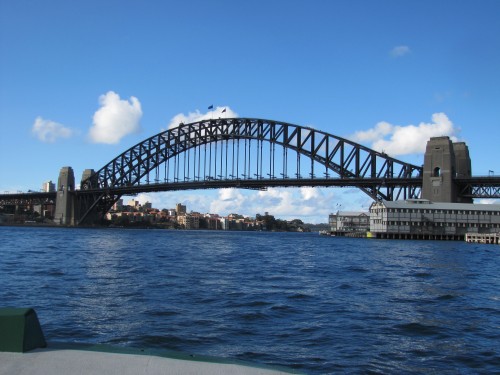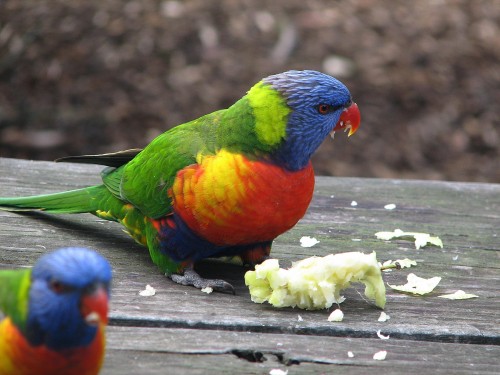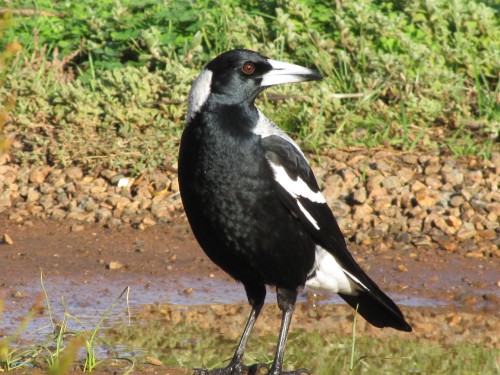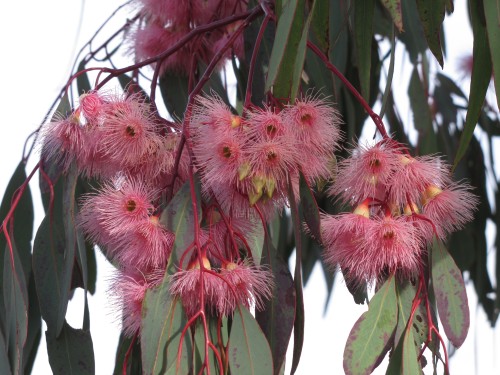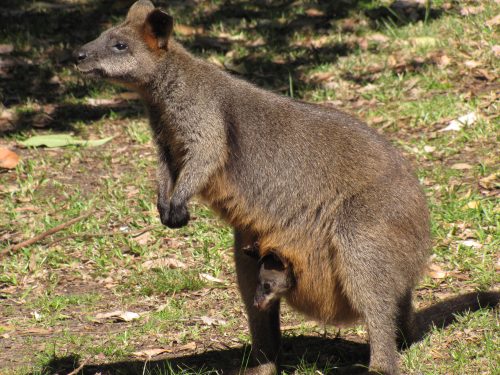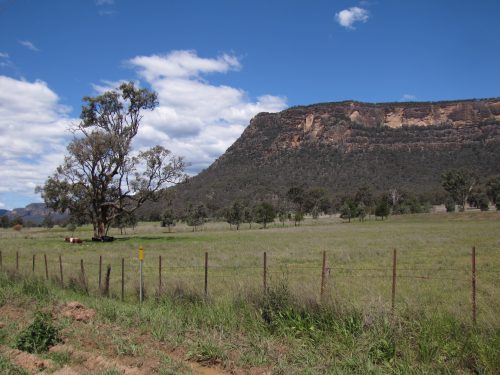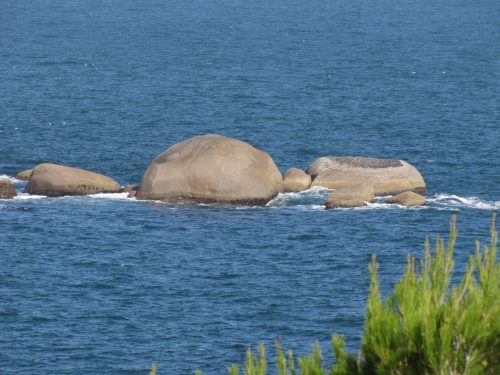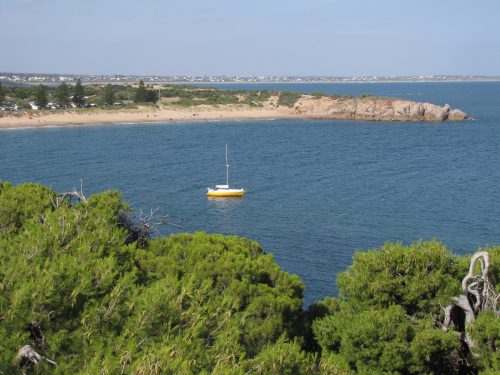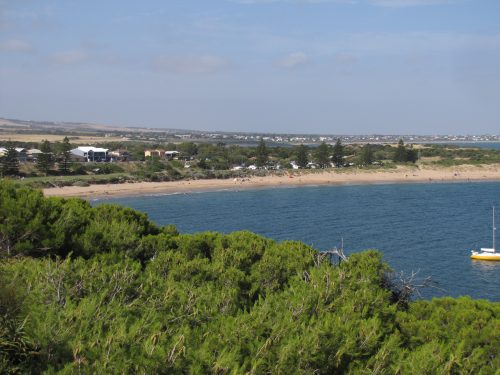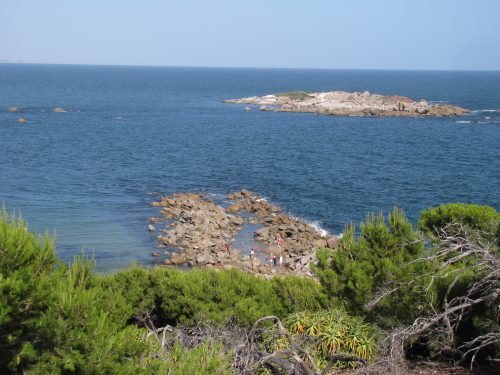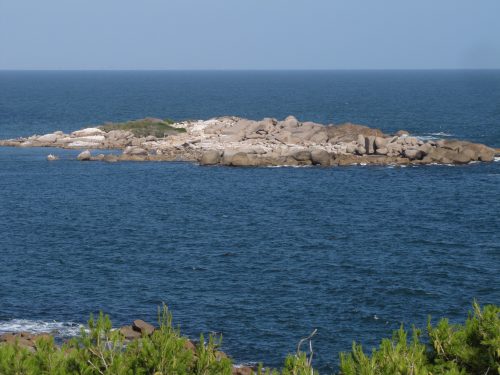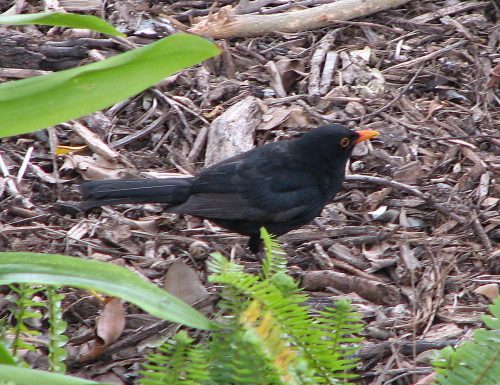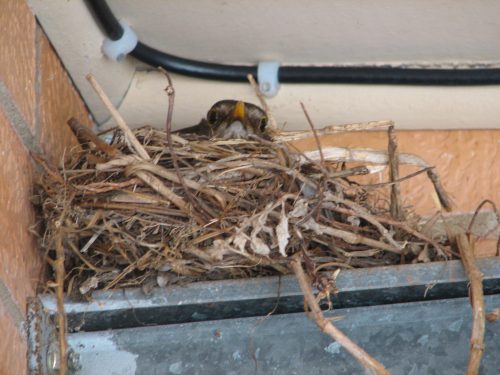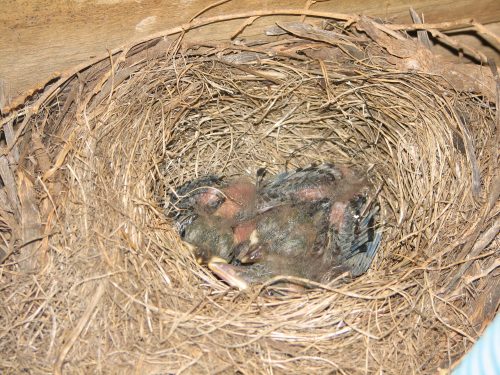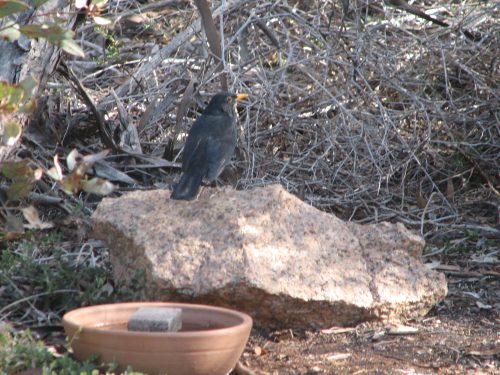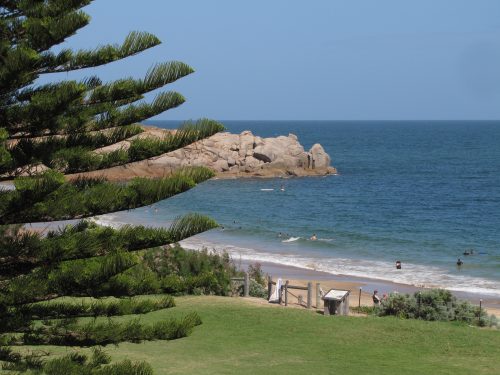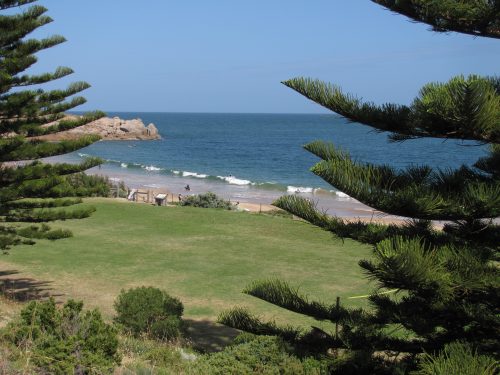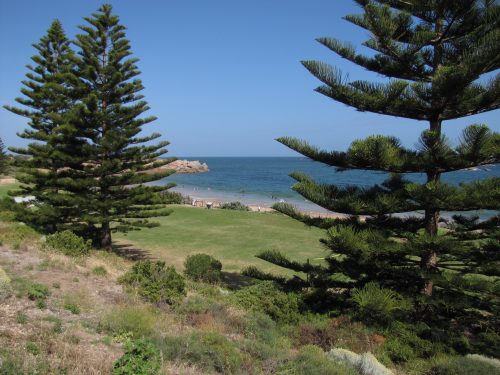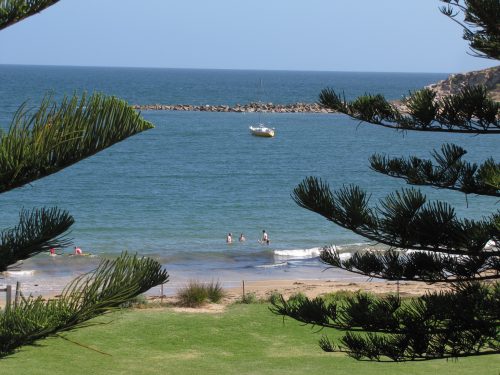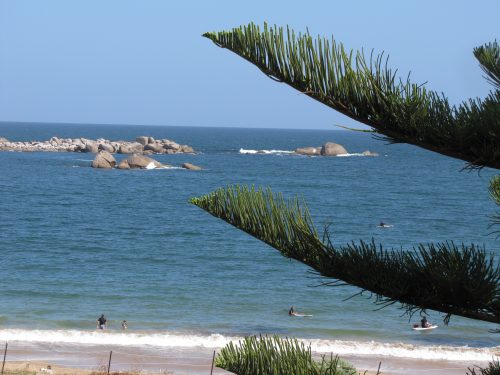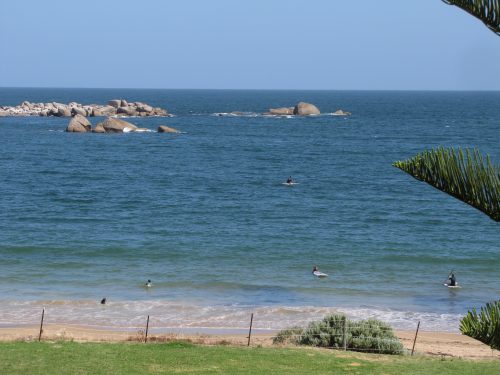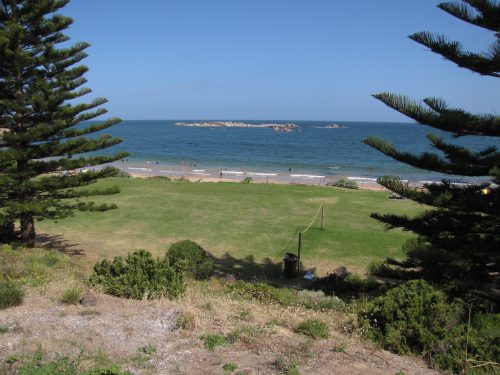Bird visitors at my window
Over recent days we have had both hot weather and lovely weather. This is normal for mid-summer days here in South Australia. For any new readers, I live about 80km or an hour’s drive south-east of Adelaide. Summer temperatures are usually in the high 20s or low 30s (30C is equal to 86F). During our worst summer days, temperatures can soar as high as 45C (113F), but thankfully such days only occur a few times every year.
Over recent weeks, many days have been in the mid-20s, which is very pleasant. On such days I love to open the large window next to my writing desk and let the fresh air into my office. If there is a breeze as well, that is an added bonus. One of the side benefits of this arrangement is the easy access to the bird life in our garden. I don’t even have to get up out of my chair to watch the birds. They come to me.
One one occasion, a friendly Australian Magpie (see photo above) sat on the rail of the pergola on this side of the house. He was in full view from where I sat. He suddenly stopped his carolling – our magpies are wonderful songsters – realised I was there and leant forward to get a better view of me. When I chatted with him, thanking him for the visit and the song, he answered me. How lovely.
On several occasions over the last week, one or two Peaceful Doves have alighted in the branches of a nearby tree, coo-ing persistently for about ten or fifteen minutes before moving on elsewhere in our garden. Their soft calls are very peaceful, so they are aptly named.
Only yesterday I had to stop what I was writing and look out to the garden bed next to my office window. A small family of White-browed Babblers were playing around in the bushes there, scolding each other as they scurried here and there. They were joined in this game by several New Holland Honeyeaters, their screeches usually a warning sign that a hawk or eagle is about. I think they were just having fun with the babblers. Even a couple of House Sparrows joined in the fun.
One species we don’t always have around is the Rainbow Bee-eaters, a delightfully named bird with their many-coloured plumage and their liking for catching and eating bees and other flying insects. I smile when I see one sitting in a nearby tree, banging a bee against the branch to dispatch the sting of the bee before swallowing it whole. Yesterday two or three could be heard out of my window while I worked, and later I saw two gliding overhead. Delightful birds, and we miss them when they fly north for the winter.
For many years we never had wrens resident in our garden. They were only occasional visitors from up the hill. Then five years ago on our return from an overseas trip, we were greeted by two Superb Fairy-wrens, one of two local species. They have been a resident breeding species in our garden ever since, producing several broods over those five years. They are so secretive about their nests that I have yet to find one. They have plenty of good bushes around to build their nests. From time to time they will also come by my office, their twittering, tinkling calls easy on the ears as they hop along near my office window, jumping up occasionally to snatch a fly or mosquito silly enough to hang around too long.
I don’t need to have the window open to hear our resident Mallee Ringneck parrots screeching outside as they fly from tree to tree, or over the house, or just sitting in a nearby tree wagging their tails joyfully. This tail wagging is probably a mating display. They have raised several broods successfully in recent years, their nest hollow being only 30 metres from my window.
What birds do you have in your garden?
Please tell me in the comments.
Good birding,
Trevor
Happy Australia Day
Today is a special day on the calendar of many Australians. Today is our national holiday – Australia Day. It was on this day in 1788 that the first European settlers arrived at Botany Bay, near Sydney. The First Fleet, a contingent of ships carrying soldiers and convicts, landed to establish the first non-indigenous settlement in what was to become Australia.
Many in modern Australia have mixed feelings about the celebration of this day, especially our Aboriginal Australians. I do not want to get into a discussion on the merits of these celebrations one way or another. All I wish to do is celebrate this wonderful land in which we live. I want to acknowledge our colourful and diverse birdlife, our beautiful flora and fauna and the amazing landscapes we enjoy.
So, today I do not wish to write very much – just show off some off the photos I have taken over the years as a celebration of this Great Land Down Under.
Have a great day. And I hope you see some wonderful birds, too.
Trevor
Further reading:
A short visit to Horseshoe Bay, Pt Elliot
Last week I wrote about my visit to Horseshoe Bay at Pt Elliot here in South Australia. This day trip from home here in Murray Bridge was to celebrate our anniversary in a relaxed and enjoyable way.
When we arrived at the picturesque seaside town of Pt Elliot on the south coast, parking at Horseshoe Bay was all taken up. This is not surprising because it was the middle of the school holidays as well as being at the height of the summer holidays here in Australia. The beach was being well used and it was crowded like I had never seen it before. The weather was perfect for swimming and lounging around on the sand, so it was not surprising that it was crowded. The nearby caravan park was also quite full, adding to the crowd on the beach.
When I couldn’t get a park near the beach I decided to try another spot nearby. We are spoilt here in South Australia because we like to park close to the beach and usually that is not a problem. We have many wonderful beaches and ample parking is available at most of them. And, unlike some I have been to in Sydney, for example, there are no parking meters to contend with. Despite this, there was not a single park – except high up on the overlooking cliff well away from the beach where we wanted to have our afternoon tea.
So, I drove the short distance to the local obelisk overlooking the bay. The car park there was almost empty, so I parked where we had a great view of the water, the bay and the nearby rocky islands in the bay. We sat in the car enjoying the vista in front of us, and the cool breeze made life very enjoyable. We enjoyed our cup of tea and home-made biscuits while soaking in the view – see today’s photos to understand what we enjoyed.
I didn’t get a chance to take many bird photos, except for the lovely shots of a Silver Gull I featured on another post here.
Further reading:
A story about Blackbirds, Honeyeaters and Cats
Common Blackbirds
Nearly 11 years ago, I wrote a simple little article on this blog about Common Blackbirds (click to read).
Never did I imagine that it would be so popular. It consistently is one of the ten most read articles on this site, and with nearly 300 comments from readers, it has obviously struck a chord with my readers.
A few days ago, one of my readers – Sue – wrote a wonderful account of the Common Blackbirds in her garden, along with comments on honeyeaters and their interactions with her pet cats. I found this account so fascinating that I have published it here in full so that more readers can enjoy her experiences.
Hi Trevor,
Great massive Blackbird thread!
I thought I would add our Blackbird experience for your consideration.We have a medium-sized block in Kensington, Adelaide, so I have a bit of garden surrounding the old villa. We have two cats, which live entirely inside with the amenity of a professionally built, fully netted enclosure on one side of the house from verandah to fence.
The honeyeaters were the first to find a way into the enclosure, by dropping through the ceiling netting which has a slightly larger grid than the wall netting, to get to the citrus trees inside. They were always faster than the one cat who has any real hunting ability. Their other advantage is that cat is deaf – so if he doesn’t see them, he doesn’t know they are there.
Then the resident pair of blackbirds learnt the same trick. For them the strip of garden along the fence and the mulched area around the compost bins are a rich source of forage. They are also faster than the cats. And they also enter and exit at speed, despite the bird seeming too large for the net.
The enclosure has vine growing over it. The vine is trained underneath on wires, and grows up through the net.
Honeyeaters chose to nest in the vine above the net. They raised a chick, then moved to the bamboo for the next round.This summer the blackbirds have built a nest in the vine IN the enclosure, UNDER the net. They fledged one enormous chick just before Christmas and to our delight have gone another round with two, possibly three, hungry chicks being fed as I type.
We were worried how the baby might get out safely, but we actually saw it fledge over a weekend. It was encouraged out of the nest, to hop around the branches, then encouraged up through the net. We have seen it in the rest of the garden with its parents several times.Mrs B doesn’t worry even when I am watering right under her. Previous behaviour for the blackbirds, the honeyeaters and even the wattlebirds is to nag me in the garden for the rain wave sprinkler then enjoy the ‘rain’. It’s not just Aussie humans that like running under the sprinkler in the hot weather.
This year the rosellas have the small hole in an old peppercorn tree, and the lorikeets had the large hole in the same tree, and were both successful.
The rest of the garden is not cat free, and there are definitely cats, rats, foxes, as well as possums and the annual koala, using it at times, but the complexity of the cat enclosure and the presence of the cats seems to keep the (non-resident) predators away from it.
In a highly artificial urban environment, we would all prefer if native species could thrive, but sometimes the imports are better suited to holding a niche. Compared to mynahs, the blackbirds seem to be a lesser of two evils. And lorikeets have proved to be pretty dominating over the smaller rosella..
Happy bird encounters, all… Sue
Thank you, Sue, for a wonderful description of the birdlife and wildlife in your suburban garden. I wish more cat lovers would be as responsible as you are with a special enclosure.
Happy birding,
Trevor
Further reading:
- Common Blackbirds – the article which started it all
- Do Blackbirds swoop? How to deal with aggressive bird behaviour – another article with over 100 comments from around the world.
- Keep your cats inside – an article I wrote some time ago about the problem of cats to the Australian environment.
- Great birding moments #7 Koala
Birds of Horseshoe Bay at Pt Elliot
Last week I wrote about a trip I took with my wife to celebrate our anniversary. We travelled from Murray Bridge to Victor Harbor which is just over an hour’s drive south-west from home. Along the way, we stopped at Milang, then at Goolwa, followed by an exploration of Hindmarsh Island, on to Pt Elliot and ended up having dinner at a favourite restaurant in Victor Harbor. While the day-trip was meant as a day out for relaxation, I had plenty of opportunities to do some casual birding wherever we stopped.
Pt Elliot is a lovely town of around 2000 population which swells in number during our long, hot summers. It is located on the south coast of the Fleurieu Peninsula and was established as a port in 1851. It boasts the reputation of having Australia’s first public railway line which extended from Goolwa. This railway line provided a means to carry cargo to and from the riverboat trade on the Murray River to seagoing ships. The mouth of the Murray River was considered too treacherous to navigate. The railway line is still in operation, though now it only carries tourists.
Pt Elliot has a delightful, and quite safe, little beach known as Horseshoe Bay. On our visit, it was very crowded despite the cool breeze. The local lawn bowls club is right next to the beach, and adjacent to the Flying Fish restaurant, known widely for its excellent seafood menu. The local caravan park just around the bay a little is very popular in the summer months.
The birdlife here is a mixture of land birds and coastal birds. Of the coastal birds, I was not able to identify many on this visit. On Pullen Island out in the bay, I could see hundreds of Silver Gulls and several Pacific Gulls. A small group of Little Pied Cormorants rested on the rocks while the occasional Whiskered Tern, Crested Tern or Caspian Tern flew overhead. On the islands, I am sure that there were a few terns as well, though my binoculars were not strong enough for me to be certain.
Away from the water, the Singing Honeyeater is a common bird of the coastal dunes and nearby bushes. Crested Pigeons can be seen throughout the town, often perched on rooftops or television antennae. Small flocks of Galahs and Little Corellas flew overhead. More frequently encountered are the Rainbow Lorikeets, either screeching as they fly low overhead, or noisily feeding on any flowering tree of bush in the gardens nearby. The lawns were attractive to the Australian Magpies, their keen eyes on the lookout for beetles, worms and other tasty morsels.
Further reading:
- Readers can go to further articles about some of the birds and places mentioned in the text by clicking on the links in blue.
